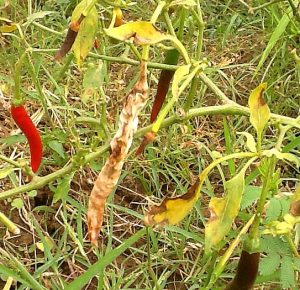
PATHOGEN: Colletotrichum spp
Disease symptoms:
Small, circular to irregular, brownish black scattered spots appear on leaves
Severely infected leaves defoliate
Infection of growing tips leads to necrosis of branches from tip backwards
Necrotic tissues appear grayish white with black dot like acervuli in the center
Shedding of flowers due to the infection at pedicel and tips of branches
Fruit symptoms
Ripe fruits are more vulnerable to attack than green ones
Small, circular, yellowish to pinkish sunken spots appear on fruits
Spots increase along fruit length attaining elliptical shape
Severe infection result in the shrivelling and drying of fruits.
Tissues around lesions will be bleached and turn white or greyish in colour and lose their pungency
On the surface of the lesions minute black dot like fruiting bodies called ‘acervuli’ develop in concentric rings and fruits appear straw coloured
The affected fruits may fall off subsequently. The seeds produced in severely infected fruits are discoloured and covered with mycelial mat.
fungus causes necrosis of tender twigs from the tip backwards the disease is called die-back Infection usually begins when the crop is in flower. Flowers drop and dry up.
There is profuse shedding of flowers. The flower stalk shrivels and dry up. This drying up spreads from the flower stalks to the stem and subsequently causes die-back of the branches and stem and the branches wither. Partia1lly affected plants bear fruits which are few and of low quality.
Favorable conditions:
Temp, 28 °C with RH more than 97%, humid weather with rainfall at frequent intervals, intercropping with turmeric which is another host of the fungus.
Controls:
Use of disease-free seeds is important in preventing the disease. Seed treatment with Thiram or Captan 4g/kg is found to be -effective in eliminating the seed-borne inoculum.
Good control of the disease has been reported by three sprayings with Ziram O. 25% Captan 0.2% or miltox 0.2%. Chemicals like wettable sulphur 0.2%, copper oxychloride 0.25% and Zineb 0.15% not only reduced the disease incidence but also increased the yield of fruits.
The first spraying should be given just before flowering and the second at the time of fruit formation.
Third spraying may be given a fortnight after second spraying.





